
Choosing the Perfect Flooring for Your Laundry Room
Introduction: The Importance of Flooring in the Laundry RoomA laundry room is more than just a utility space; it’s a hardworking area that deserves as much attention to style and design as any other room in your home. Choosing the right flooring for a laundry room can be challenging since it must balance durability with aesthetic appeal, all while withstanding high moisture levels and heavy use. In this post, we'll explore how to select a flooring option that meets the unique demands of a laundry room while seamlessly blending with the home’s decor. We’ll walk through nine key considerations that help determine the best choice, addressing both functionality and style to create a space that’s as stylish as it is practical.
1. Room Purpose
The laundry room is a high-traffic, high-function space that endures plenty of wear and tear. Flooring in this room must be resilient enough to withstand the weight and vibrations of large appliances while remaining easy to clean and moisture-resistant. For this reason, materials like tile and luxury vinyl are popular choices as they are highly durable, water-resistant, and easy to maintain. Tile, in particular, offers unmatched durability and can handle the occasional spills and leaks that come with laundry tasks. With luxury vinyl, you get a similar resilience with a softer underfoot feel, making it a comfortable yet sturdy choice.
2. Design Style
Your laundry room’s design style should align with the rest of your home’s aesthetic, creating a cohesive feel throughout. Flooring options like patterned hypoallergenic or wood-look luxury vinyl can enhance your space's design, adding a layer of warmth or a hint of modernity. For instance, if your home leans towards a farmhouse aesthetic, a wood-look luxury vinyl plank might be a perfect fit. On the other hand, ceramic tile in contemporary patterns or colors can add a pop of style for a more modern or eclectic look. The flooring choice here plays a dual role in reinforcing your chosen style while ensuring practical functionality.
3. Durability
Given the heavy-duty nature of laundry room activities, durability is non-negotiable when selecting flooring. Tile and environmental impact (eco-friendly) are both excellent options, offering high resistance to wear and scratches. Tile is known for its unmatched hardness and longevity, making it a strong choice for homeowners who want low-maintenance flooring. LVP, while slightly less durable than tile, is highly scratch-resistant and capable of withstanding the demands of a laundry space, making it a resilient yet visually appealing option for this environment.
4. Moisture Exposure
Laundry rooms experience a high level of moisture due to water spills, humidity from drying clothes, and the potential for leaks. Water-resistant or waterproof flooring, such as resilient or ceramic tile, as well as waterproof LVP, are ideal choices for this reason. Tiles are fully impervious to water, allowing them to stand up to frequent moisture exposure without warping or damage. Waterproof luxury vinyl also performs well under damp conditions, providing peace of mind and reducing the risk of mold or mildew.
5. Budget
When working within a budget, hypoallergenic options like eco-friendly and LVP are generally more affordable than tile while still offering excellent durability and water resistance. Tile may have a higher upfront cost, especially if installation requires professional help, but it offers a longer lifespan and virtually maintenance-free upkeep. If budget constraints are a concern, luxury vinyl plank is a highly cost-effective alternative, balancing affordability with resilience and style.
6. Subfloor Condition
The condition of your subfloor will impact your choice of flooring. For example, tile requires a stable, level subfloor to prevent cracking over time. LVP, on the other hand, is more forgiving and can often be installed over an existing floor without extensive preparation. If your subfloor isn’t perfectly level or if you’d like to avoid the costs of subfloor repairs, LVP can be a practical and visually appealing solution that accommodates slight imperfections without sacrificing stability.
7. Eco-Friendliness
If sustainability is a priority, consider eco-friendly flooring options that minimize environmental impact. Tiles made from recycled materials or vinyl cushion with eco-certifications offer greener options for homeowners aiming to reduce their footprint. Vinyl options, particularly those free of harmful chemicals, are now widely available and can contribute to a healthier, more eco-friendly home environment.
8. Soundproofing and Insulation
Soundproofing is a key consideration in laundry rooms where washers and dryers can be noisy. Tile can amplify sound, making vinyl a better option if you want to reduce noise levels. Luxury vinyl, due to its slightly softer composition, provides a more sound-absorbent surface, making it a smart choice for noise control. Additionally, adding an insulating underlayment beneath vinyl flooring can further reduce noise and create a quieter, more comfortable space.
9. Health Considerations
When it comes to health, vinyl flooring has come a long way with low-VOC (volatile organic compound) options available, which contribute to better indoor air quality. Porcelain and ceramic tiles are also excellent choices for health-conscious homeowners, as they are hypoallergenic, easy to clean, and do not emit VOCs. This makes them particularly suitable for households with allergies or sensitivities, contributing to a healthier living space overall.
Color Scheme and Visual Appeal
Flooring color and pattern have a significant impact on a laundry room's visual appeal. Opting for a neutral-colored tile or vinyl in shades of gray, beige, or wood tones can create a clean and timeless look that won’t quickly go out of style. Alternatively, indoor air quality can bring a lively, unique look that adds personality to the space. Flooring should complement the room's color scheme and overall decor, enhancing its visual appeal while making the room feel bright and welcoming.
Style and Theme Coherence
Choosing flooring that aligns with the overall theme of your home ensures a cohesive design flow. For instance, a minimalist laundry room would benefit from simple, sleek flooring like solid-colored tiles, whereas a rustic theme might be enhanced with wood-look vinyl. By aligning your laundry room flooring with the home’s style, you achieve a sense of unity and balance that enhances the entire home’s design continuity.
Texture and Feel
The texture of the flooring is essential, not only for aesthetics but also for safety in a moisture-prone space. Textured vinyl or matte-finish tiles can provide a slight grip, reducing the risk of slipping. This not only enhances the room's feel but also adds a functional safety feature, ensuring that wet surfaces are less hazardous during laundry tasks.
Room Size Perception
The flooring choice can also influence the room’s perceived size. For example, larger tiles or planks can make a smaller laundry room appear more spacious, while small, intricate patterns can add interest but may feel busier in a compact area. Choosing light-colored flooring can also help make a laundry room feel larger, creating an open, airy effect.
Comfort and Usability
The comfort level of the flooring is especially important for a room where you’ll be standing frequently. Luxury vinyl provides a softer surface compared to tile, offering a little more comfort underfoot during laundry chores. For added comfort, you might consider an underlayment beneath the vinyl, which provides both cushioning and insulation benefits.
Acoustic Impact
Laundry rooms can be noisy spaces due to the hum and vibration of appliances, so soundproofing is crucial. Tile can often echo sounds, whereas luxury vinyl helps to absorb sound, reducing noise levels in this busy space. Adding a cushioned underlayment beneath vinyl can enhance sound absorption, creating a quieter and more pleasant room environment.
Pattern and Focal Points
The choice of flooring pattern can also affect how other design elements stand out. For instance, choosing a neutral, solid-colored floor allows the room's cabinetry and appliances to take center stage. In contrast, a patterned tile can serve as a focal point, drawing attention to the floor itself and adding a unique design element to the space.
Final Thoughts
Selecting the right flooring for your laundry room requires a blend of practical and aesthetic considerations, from durability and moisture resistance to style and comfort. Each flooring type has its unique benefits, but options like tile and luxury vinyl offer a balanced combination of style, durability, and water resistance, making them ideal choices for this hardworking room. Whichever option you choose, focusing on functionality without sacrificing visual appeal will ensure a laundry room that’s both beautiful and efficient. By considering each aspect of your lifestyle and design goals, you can create a space that makes even the most mundane chores feel a little more enjoyable.
Choose Flooring Product : LVT/LVP Ideas (1)
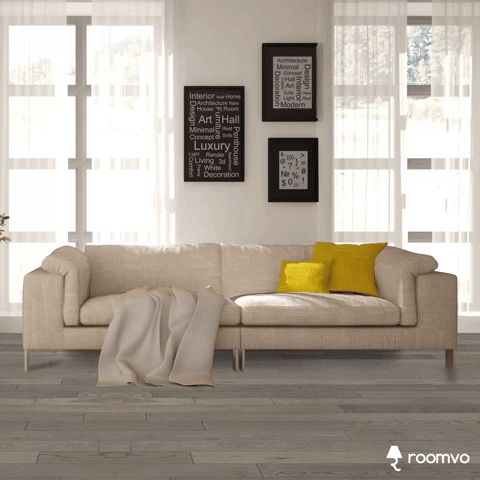
roomvo
Visualize Flooring In Your laundry room!
Roomvo makes picking new floors easy. Take advantage of our room visualizer tool to see what your home will look like with any flooring products from our catalog. Just upload your photo to see your room come to life.
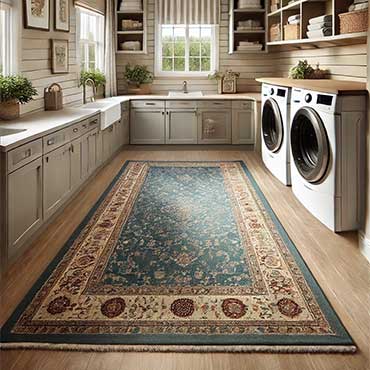 Blog
BlogLaundry Room - Area Rugs
Should You Use Area Rugs in the Laundry Room? Expert Design Tips
This blog post explores the innovative use of laundry room in the laundry room,h5targeting interior designers and decorators. Drawing from Arabella Whitethorn'sh5expertise, it delves into key considerations like room purpose, moistureh5resistance, and design coherence, offering practical advice for creating a spaceh5that combines style and functionality. The post highlights the pros and cons ofh5area rugs, emphasizing their role in enhancing aesthetics, comfort, andh5soundproofing while addressing challenges like durability and maintenance.
By integrating thoughtful design principles, this post inspires professionalsh5to consider how area rugs can transform even the most utilitarian spaces, makingh5the laundry room a stylish extension of the home.
Learn More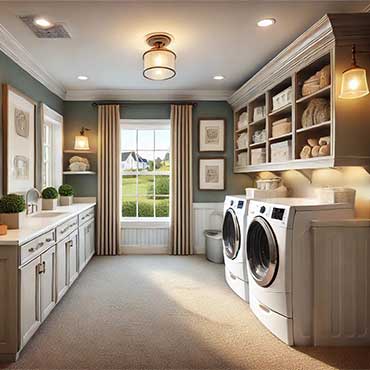 Blog
BlogLaundry Room - Carpeting
Carpeting in Laundry Rooms: A Designer's Guide to Comfort and Functionality
This blog post explores the viability of using laundry rooms in laundry rooms, balancing the functional needs of this utilitarian space with the aesthetic aspirations of high-end design. Arabella Whitethorn delves into key considerations like durability, moisture exposure, and style coherence, evaluating the pros and cons of carpeting in a room prone to heavy use and humidity. The post offers designers valuable insights, discussing how carpeting's warmth and soundproofing capabilities may align with client goals while addressing its challenges in practical applications.
By examining nine critical factors, this post empowers interior designers and decorators to make informed decisions when recommending flooring options for laundry rooms. Whether integrating carpets for their luxurious feel or opting for resilient alternatives, the post emphasizes the importance of tailoring choices to enhance the space’s functionality and harmony.
Learn More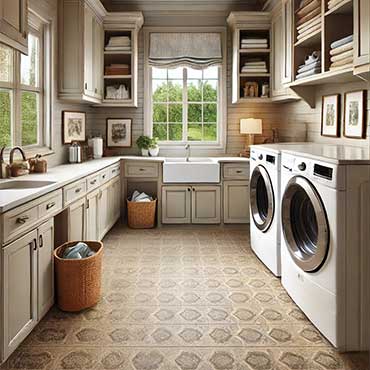 Blog
BlogLaundry Room - Ceramic Tile
Timeless Ceramic Tile for Laundry Rooms: A Designer's Guide
Ceramic tile is an exceptional flooring choice for laundry rooms, offering a unique combination of style, durability, and practicality. In this blog post, Arabella Whitethorn explores the suitability of eco-friendly in a laundry room, considering its ability to withstand moisture, resist wear, and complement various design styles. By examining key factors like room purpose, design cohesion, and sustainability, Arabella provides a comprehensive guide for interior designers and decorators. This material's versatility shines through its wide range of colors, textures, and patterns, making it adaptable to diverse aesthetics, from minimalist to bold and vibrant.
The post also highlights the practical advantages of ceramic tile, including its eco-friendly composition and resistance to allergens, mold, and bacteria, ensuring a healthy and safe space. While discussing potential challenges like coldness underfoot and the need for careful grout maintenance, Arabella offers creative solutions to overcome these concerns, such as incorporating underfloor heating or textured finishes. With detailed insights, this blog equips designers with the tools to confidently incorporate ceramic tile into laundry room designs, balancing form and function to create efficient, visually captivating spaces.
Learn More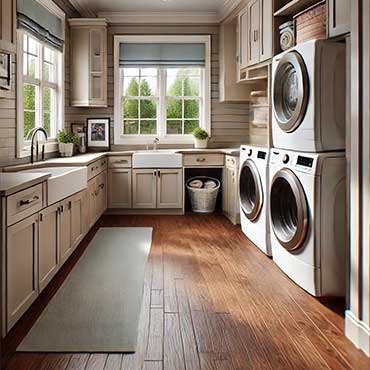 Blog
BlogLaundry Room - Hardwood Flooring
Engineered Hardwood Flooring in Laundry Rooms: Style Meets Functionality
flooring is a popular choice among interior designers and decorators for its ability to balance timeless beauty with modern practicality. This blog post explores the suitability of engineered in laundry rooms, a space that demands a unique blend of durability, moisture resistance, and aesthetic appeal. From its layered construction that offers enhanced stability to its variety of finishes that seamlessly complement design styles, this flooring type offers both visual elegance and functional benefits. However, its performance in high-moisture environments requires thoughtful considerations, such as proper sealing and ventilation, to ensure longevity.
Through detailed insights into key design factors like durability, eco-friendliness, budget, and health considerations, the post provides a comprehensive guide to incorporating engineered hardwood flooring in laundry rooms. With tips for installation and maintenance, as well as a breakdown of its pros and cons, this article equips interior designers and decorators with the knowledge they need to make informed decisions for their projects. Whether prioritizing cohesive aesthetics or functionality, readers will find valuable advice tailored to elevate laundry room designs.
Learn More






